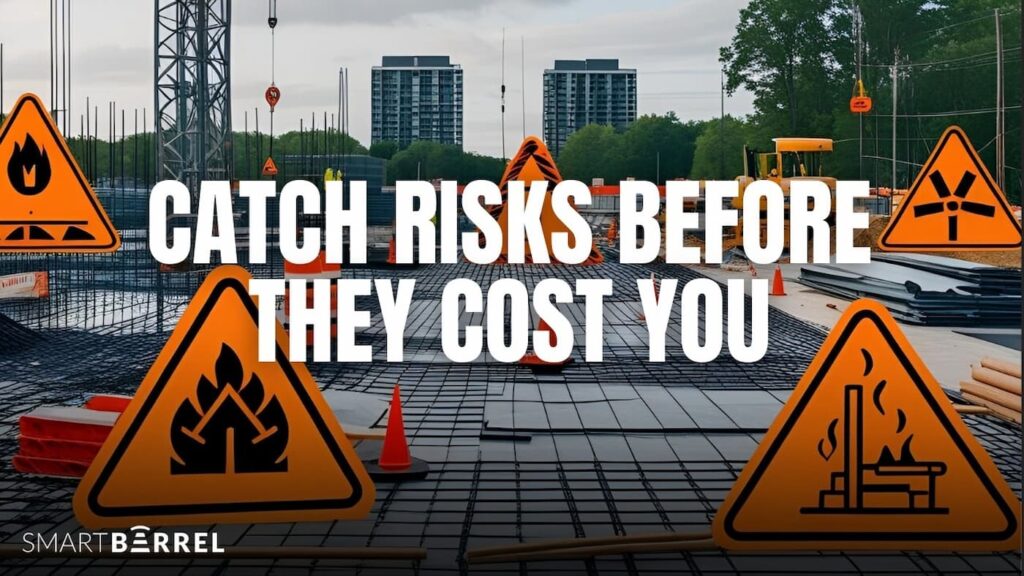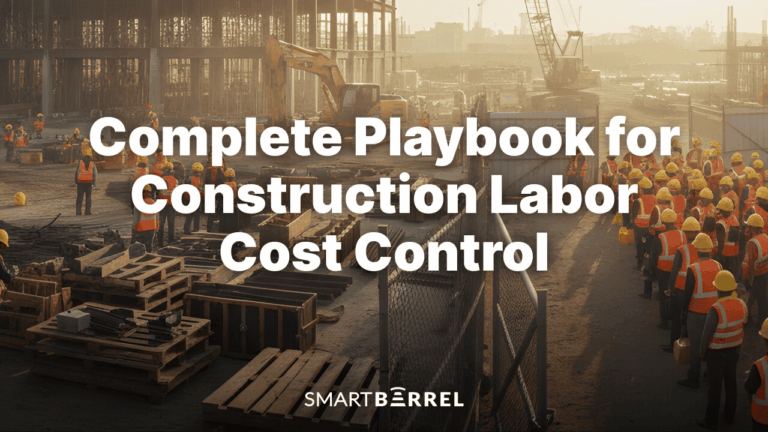Every construction site has hidden risks lurking around the corner that cost you money when they’re ignored. One missed delivery, one crew delay, or one communication gap can throw off the entire schedule and eat into profit. But seasoned subcontractors don’t cross their fingers and hope it’ll work out — they build clear daily systems that keep jobs moving, even when things get rough. That’s what keeps costs down and jobs on track, no matter what comes up.
Construction is full of moving parts: people, materials, time, weather, and paperwork. The trick isn’t pretending you can avoid every problem. It’s spotting hidden risks early and backing up every step with clear daily logs, verified hours, and smart planning. That’s what this guide does — real tactics to control risks before they control your job.
What Is Risk Management in Construction?
Construction risk management is about preparation. It means spotting hidden risks before they turn into real costs and putting clear systems in place so you can deal with problems early. You can’t plan for every curveball, but recognizing patterns and keeping daily records helps keep surprises small and profit steady.
Many daily tasks already reflect risk management. Checking weather before a pour, reviewing delivery schedules, and training crews on safety are simple steps that prevent problems. The difference is turning those habits into consistent, documented systems. Clear daily logs, verified time tracking, and steady communication help teams stay in control instead of reacting after the fact.
A strong construction risk management plan covers key areas like:
- Labor and crew availability
- On‑site safety and compliance
- Financial tracking and billing
- Scheduling and delays
- Documentation and communication
- Data protection and technology usage
When these parts run on real, verified data, projects run smoother. Crews know what to do, records stay organized, and hidden risks stay small.
Get Control of Your Time Tracking
Hidden Labor Risks That Eat Profit
Labor is the heart of your operation. Nothing moves forward without the right people on site and working efficiently. But labor-related construction risks are some of the biggest hidden costs contractors face. No-shows, late starts, and sloppy time tracking can throw off schedules and eat into margins fast.
Biometric time tracking helps solve risk management for construction projects. Biometric photo ID and location checks make sure the right crew is on site when they say they are. Everyone stays accountable, and small problems get caught before they grow. Tools like SmartBarrel provide this level of confidence with facial verification and geofencing, helping verify your time tracking.
But tracking alone is not enough. Daily crew planning matters just as much. Foremen should have clear task lists and check work at the end of each day. Train foremen to spot problems early and speak up fast. It is always better to shift crews in the morning than find missing hours later.
Labor risk is not about blaming workers. It is about building clear systems so you can see issues early and adjust without slowing the whole job down.
Safety and Compliance Risks
Construction sites are busy, physical spaces. Things move fast. That’s why safety needs to be part of the rhythm. One construction hazard at your job site can stop your work, trigger inspections, and add extra costs you didn’t plan for. But more importantly, safety protects your people.
Start with short, daily safety meetings. They don’t need to take long. Five minutes before the shift, with everyone checking in and signing off, is enough to keep safety in mind. Use digital attendance with facial verification (like the kind SmartBarrel provides) to confirm who was present. That way, you always have clean records.
Track every incident. Even a small cut or trip should be logged. This is not to add paperwork, but to prevent something worse next time. Run occasional surprise audits to make sure PPE is being used and rules are followed.
Managing risks in construction isn’t about checking boxes. It’s about creating a jobsite where people move confidently and work at full speed without second-guessing. That’s the importance of risk management in construction. Protecting people while keeping the job moving.
Financial and Budget Risks
When you lose track of time, you lose control of your budget. Missed hours, late billing, or unapproved work all lead to one thing: shrinking margins. Often, these financial losses happen in small pieces. A few hours here. A skipped approval there. But over time, they add up and drain the job.
Verified time tracking keeps this in check. Crews log labor as it happens. Supervisors sign off daily. Everything is backed by photos, time stamps, and location checks. No chasing missing forms or arguing later about what was done.
Make sure every change order is clear and approved before work starts. If the scope shifts mid-job and nobody records it, odds are you will not get paid for that extra work.
With the right systems in place:
- You catch every hour.
- You protect every dollar.
- You stay ready for client audits with clean records.
Good construction risk management is about control. When your hours and approvals stay tight, hidden costs stay small and margins stay healthy.
Get Control of Your Time Tracking
Scheduling and Delay Risks
Schedules don’t usually break all at once. They slip in small ways. These include late deliveries, slow progress, and short crews. And before you know it, the project is off track. That’s why delays are one of the most dangerous risks in construction projects. They start small but hit hard.
The best fix? Stay ahead of them. Add buffer days around key items. Don’t schedule back‑to‑back tasks with no room to breathe. Track daily output, not just weekly goals. That way, if progress dips, you can catch it early and recover fast.
Daily check-ins with your crew, field supervisors, and subs can uncover problems before they blow up. And when materials are involved, always plan for a lead time buffer. Don’t wait until you’re nearly out of stock to order what’s next.
Delays do not have to derail a job. The right habits, daily tracking, clean logs, and clear comms help you adjust fast and keep the schedule tight. That is what good construction risk control looks like on the ground.
Documentation and Communication Risks
If it is not documented, it did not happen. That might sound harsh, but it is the truth in any construction project. Verbal agreements feel quick in the moment, but they are hard to prove when issues come up. And when money is on the line, clear records are part of good construction risk management.
Start with daily crew logs. Let teams track what was done, where, by whom, and when. Add a simple signature or supervisor sign-off. Photos with timestamps help tell the full story. It does not take long, but it creates clear documentation that keeps construction risks under control.
Use one system across the job. There is less confusion and fewer delays when the field, office, and clients share the same records. Everyone can see what is happening, ask questions early, and confirm changes before they turn into bigger problems.
Good documentation and communication protect your team. They keep the construction project on track and make sure you get credit and payment for every hour and task done.
Technology and Data Security Risks
Most crews today use some kind of technology. But not every system is built for real construction work. A simple spreadsheet might do the job for a while, until someone deletes it, loses the file, or logs bad data. That is when construction risks show up. You do not just lose time; you lose trust, money, and project history.
Use a cloud-based system that stores data across devices and saves work automatically. If a phone breaks or someone logs out early, nothing is lost. Make sure your system works offline too. Many job sites have poor signal, and you do not want work to stop because Wi-Fi is down.
Assign access by role. Field crews log tasks, supervisors approve, and PMs review. Everyone sees what they need and nothing more. Use automatic backups so records are always safe and easy to find.
The right tools do not add work. They remove friction. Good technology supports clear records, clean approvals, and secure backups. That is smart construction risk management and risk identification in construction projects. It helps teams manage risks in construction the right way and keeps small problems from turning into big costs.
Subcontractor Coordination Risks
Even when your own crew runs tight, other subs can create delays. A late team or a vendor who misses a delivery can push your whole schedule off track. That is why subcontractor and vendor coordination is one of the biggest hidden construction risks.
Set clear expectations up front. Define scope, deadlines, deliverables, and penalties. Put everything in writing. Check references before you bring in a new sub. Once work starts, hold quick check-ins to catch problems early. These meetings do not have to take long, but they help flag issues before they grow.
Always have a backup plan. Keep extra vendor contacts for critical materials or labor. You may not need them every time, but when a problem comes up, they can save the job from bigger delays.
Good construction risk management shows that third-party delays are a real threat. Construction risk analysis and regular risk assessment help you spot these gaps early and plan around them. With strong preparation, subcontractor risks stay small, and work keeps moving.
Get Control of Your Time Tracking
Conclusion
You can’t stop every problem on a construction job. That’s not the goal. The real goal is to spot risk early, have a plan, and stay in control. Whether it’s labor, safety, budget, or schedule, your systems decide how well the job moves.
The best subcontractors do not get lucky. They get ready. They use tools like SmartBarrel to verify crews on site, keep daily records tight, and catch small risks before they kill your margin. That’s construction risk management in practice, real data that protects trust and keeps jobs moving. You already know how to build. Now, protect your margin with daily systems that work as hard as you do.





